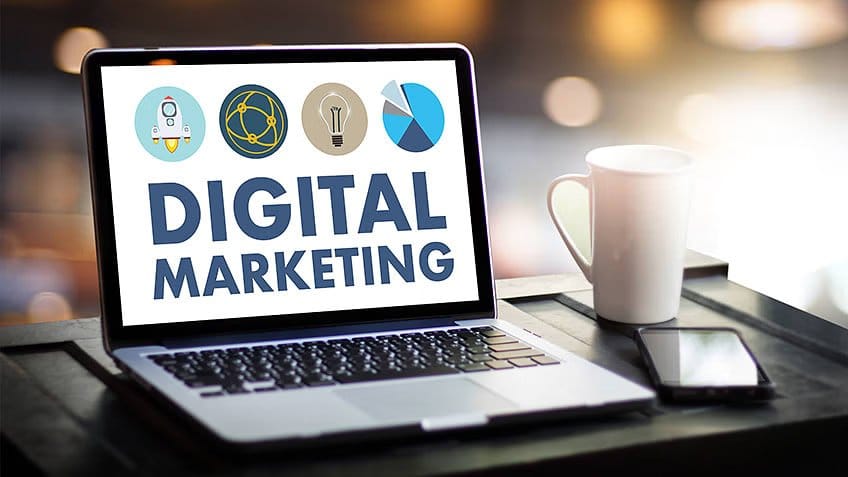What is Digital Marketing? Types and Strategies
Explanation: In today’s fast-paced, technology-driven world, Digital Marketing has emerged as one of the most effective tools for businesses of all sizes. Digital Marketing allows brands to reach their target audience, create a strong online presence, and drive business growth. This article will provide an overview of Digital Marketing, discuss its various components, and explain why it is crucial for businesses in the modern age.
What is Digital Marketing?
Digital Marketing refers to the use of digital channels, such as websites, social media platforms, email, search engines, and mobile apps, to promote products or services. Digital Marketing encompasses a wide array of strategies and tactics designed to engage consumers and convert leads into loyal customers. Unlike traditional marketing, which primarily relies on print media, and television ads, digital marketing leverages the internet to deliver personalized and interactive content.
The key advantage of Digital Marketing lies in its ability to track and analyze consumer behavior in real-time, offering businesses valuable insights into customer preferences and campaign effectiveness. Digital Marketing allows for data-driven decision-making, enabling businesses to adjust their strategies based on performance metrics. Moreover, Digital Marketing is often more cost-effective than traditional methods, offering a higher return on investment (ROI) due to its precise targeting capabilities.
Types of Digital Marketing
Digital Marketing encompasses a variety of techniques and platforms to reach and engage target audiences effectively. Here are the major types of digital marketing:
- Search Engine Optimization (SEO):
- Involves optimizing a website to rank higher in search engine results, thereby increasing organic traffic.
- Techniques include keyword optimization, improving website speed, mobile optimization, and building backlinks.
- Content Marketing:
- Focuses on creating and distributing valuable, relevant content to attract and retain a target audience.
- Content can include blog posts, videos, info graphics, podcasts, and more.
- Social Media Marketing:
- Uses social media platforms like Facebook, Instagram, Twitter, LinkedIn, and TikTok to promote products or services.
- Involves both organic content creation and paid advertising to engage users and grow brand awareness.
- Email Marketing:
- Involves sending targeted emails to a segmented audience to promote products, services, or content.
- Common email marketing strategies include newsletters, promotional campaigns, and personalized recommendations.
- Pay-Per-Click Advertising (PPC):
- A paid advertising model where businesses pay a fee each time their ad is clicked, commonly used on search engines (e.g., Google Ads) and social media platforms.
- Provides quick visibility and are highly targeted based on keywords, demographics, and user behavior.
- Affiliate Marketing:
- Performance-based marketing where businesses partner with affiliates (such as influencers, bloggers, or other companies) who promote their products or services in exchange for a commission on sales or leads.
- Influencer Marketing:
- Leverages influencers or individuals with a large and engaged following to promote products or services to their audience.
- Works particularly well in industries such as fashion, beauty, tech, and lifestyle.
- Video Marketing:
- Uses video content to engage and inform audiences, often through platforms like YouTube, Video, or embedded videos on websites.
- Includes tutorials, product demonstrations, and brand storytelling to connect with customers.
- Display Advertising:
- Involves placing banner ads, rich media ads, and interactive ads on websites, apps, or social media to promote products or services.
- Often operates on a pay-per-impression or pay-per-click model.
- Mobile Marketing:
- Focuses on reaching consumers through their Smartphone’s and tablets via SMS, push notifications, mobile apps, or in-app advertising.
- Mobile marketing also includes optimizing websites and content for mobile devices.
- Native Advertising:
- Integrates promotional content in a way that matches the look and feel of the platform on which it appears, such as sponsored articles or social media posts.
- It’s designed to be less intrusive and more engaging than traditional ads.
- Online Public Relations (PR):
- Involves managing a brand’s reputation through online channels such as digital press releases, social media mentions, and engaging with bloggers and online influencers to spread positive news or handle crises.
Each type of Digital Marketing offers unique opportunities for businesses to connect with their target audience and should be used in combination for the best results.
Strategies of Digital Marketing
- Content Marketing Strategy
Description: Focuses on creating, distributing, and promoting valuable content to attract and engage a target audience. Tactics: Blogging, videos, infographics, eBooks, case studies, white papers, and more. Goal: Build brand authority, nurture leads, and drive conversions by delivering informative and engaging content.
- Search Engine Optimization (SEO) Strategy
Description: Enhances visibility on search engines through organic optimization techniques. Tactics: On-page SEO (keywords, meta tags), technical SEO (site speed, mobile-friendliness), and off-page SEO (backlinks). Goal: Improve search engine rankings, increase organic traffic, and build credibility.
- Social Media Marketing Strategy
Description: Uses social media platforms to promote products or services and engage with the audience. Tactics: Paid ads, influencer partnerships, organic posts, engagement campaigns, and brand storytelling. Goal: Increase brand awareness, foster engagement, and create a community around the brand.
- Email Marketing Strategy
Description: Involves sending targeted and personalized emails to a segmented audience to nurture relationships. Tactics: Newsletters, promotional campaigns, drip marketing, and personalized product recommendations. Goal: Build long-term relationships, nurture leads, and convert prospects into customers.
- Pay-Per-Click (PPC) Advertising Strategy
Description: Paid advertising where businesses pay each time someone clicks on their ads Tactics: Google Ads, Bing Ads, and social media advertising (e.g., Facebook Ads). Goal: Drive targeted traffic quickly, generate leads, and boost sales.
- Influencer Marketing Strategy
Description: Partnering with influencers or thought leaders to promote products or services. Tactics: Sponsored content, product reviews, collaborations, or ambassadorships. Goal: Reach new audiences, build brand credibility, and increase conversions through trusted endorsements.
- Affiliate Marketing Strategy
Description: A performance-based strategy where affiliates promote products in exchange for commissions. Tactics: Using affiliates (bloggers, influencers) to promote products/services through links or banner ads. Goal: Drive traffic and sales through affiliates while minimizing upfront costs.
- Conversion Rate Optimization (CRO) Strategy
Description: Focuses on optimizing the website or landing pages to increase the percentage of visitors who convert (e.g., sign up, purchase). Tactics: A/B testing, improving user experience, refining calls-to-action, and optimizing landing pages. Goal: Increase conversion rates and get more value out of existing traffic.
- Video Marketing Strategy
Description: Utilizes video content to engage, educate, and convert audiences. Tactics: YouTube marketing, social media videos, tutorials, product demos, and webinars. Goal: Boost engagement, build trust, and increase conversions through compelling video content.
- Mobile Marketing Strategy
Description: Targeting users on their mobile devices via SMS, apps, social media, and mobile-optimized websites. Tactics: Mobile ads push notifications, in-app marketing, and SMS campaigns. Goal: Reach and engage with users directly on their smartphones for better interaction and conversion.
By combining these strategies based on your audience and goals, you can build a robust and effective digital marketing plan to drive growth and success.
Conclusion:
Digital Marketing emphasizes its critical role in modern business strategies. Digital Marketing allows businesses to reach a global audience, target specific demographics, and measure the impact of campaigns in real-time. However, it requires continuous innovation and adaptation to evolving technologies and consumer behaviors.
Read More: Local SEO Tips for More Traffic in 2022

